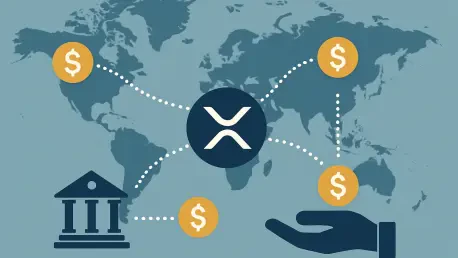In an era where global financial transactions are often bogged down by inefficiencies, high costs, and sluggish processing times, XRP, a digital asset within the Ripple ecosystem, stands out as a transformative force. As cross-border payments continue to surge, with projections estimating the market to exceed $250 trillion annually by 2030, the need for faster, cheaper, and more transparent systems has never been more pressing. Traditional methods, reliant on outdated infrastructures, frequently fail to meet these demands, leaving a gap that innovative technologies are eager to fill. XRP, through its integration with RippleNet, offers a compelling solution by leveraging blockchain to streamline international transfers. This article delves into the pivotal position XRP holds in the fintech landscape, examining its alignment with global financial standards, its impact on payment efficiency, and its growing traction among institutional players. The journey of XRP reveals a digital asset poised to redefine how money moves across borders.
Aligning with Global Standards for Seamless Integration
The strategic importance of XRP in fintech is significantly tied to RippleNet’s compliance with ISO 20022, a widely adopted international standard for financial messaging that ensures interoperability among banks and payment platforms. Since adopting this framework several years ago, RippleNet has enabled smooth integration with traditional financial systems, even though the underlying XRP Ledger operates on a distinct technical structure not natively aligned with the standard’s format. This compliance acts as a critical link, allowing XRP to function within regulated environments while maintaining the agility of blockchain technology. For financial institutions seeking to modernize without abandoning established protocols, RippleNet’s adherence to global norms provides a trusted pathway. This positioning not only enhances XRP’s credibility but also broadens its applicability in a sector where regulatory alignment is often a prerequisite for adoption, setting it apart from many other digital assets.
Furthermore, this alignment with ISO 20022 underscores XRP’s role as a bridge between conventional banking and innovative fintech solutions. By facilitating standardized communication, RippleNet ensures that transactions involving XRP can be seamlessly processed across diverse financial networks, reducing friction that often plagues cross-border dealings. This capability is particularly vital as global finance increasingly demands interoperability to handle the complexities of international trade and remittances. Unlike purely speculative cryptocurrencies, XRP gains practical relevance through this integration, appealing to banks and payment providers wary of untested technologies. The result is a growing acceptance among institutions that see XRP not just as a digital token, but as a functional component of a modernized financial ecosystem, ready to tackle the inefficiencies of legacy systems with precision and reliability.
Transforming International Transfers with Efficiency
One of the most compelling aspects of XRP lies in its utilization within Ripple’s On-Demand Liquidity (ODL) service, a mechanism designed to revolutionize cross-border payments by using XRP as a bridging asset. Traditional systems often require days to process large transfers, with fees that can erode a significant portion of the transaction value—sometimes up to 8% for multi-million-dollar payments. In stark contrast, ODL enables near-instantaneous settlements, often completed in seconds, with costs typically below 1%. This dramatic reduction in both time and expense addresses a critical pain point in global finance, making XRP an attractive option for institutions handling frequent or high-volume international transactions. As the demand for efficient payment solutions grows, XRP’s role in facilitating real-time liquidity positions it as a frontrunner in reshaping how money crosses borders.
Beyond speed and cost, the transformative potential of XRP through ODL lies in its ability to eliminate the need for pre-funded accounts in destination countries, a common bottleneck in traditional payment systems. By leveraging XRP as an intermediary, financial entities can bypass the cumbersome process of maintaining Nostro and Vostro accounts, freeing up capital that would otherwise be tied up in these arrangements. This innovation not only enhances operational efficiency but also reduces risk exposure for banks and payment providers navigating volatile currency markets. As more institutions recognize the practical benefits of this approach, the adoption of XRP for cross-border transactions is likely to accelerate, further cementing its status as a key player in the fintech arena. The shift toward such streamlined processes signals a broader trend of modernization that XRP is uniquely equipped to lead.
Building Institutional Confidence and Regulatory Stability
A significant driver behind XRP’s rising prominence in fintech is the trust it has garnered from over 400 financial institutions across regions like Asia, the Middle East, and Latin America, largely due to RippleNet’s commitment to global compliance standards. This trust is reinforced by a landmark legal resolution with the U.S. Securities and Exchange Commission earlier this year, which confirmed XRP’s classification as a non-security in secondary markets, alleviating long-standing regulatory uncertainties. Such clarity has paved the way for broader acceptance among risk-averse entities, including the anticipated launch of the ProShares Ultra XRP ETF by October of this year, a development expected to draw substantial investment from pension funds and endowments. This growing institutional confidence highlights XRP’s unique ability to straddle the line between innovative technology and regulated finance, making it a standout in the digital asset space.
Moreover, the regulatory stability surrounding XRP has far-reaching implications for its adoption as a legitimate financial tool. With legal hurdles cleared, financial institutions are more inclined to integrate XRP into their operations, viewing it as a safe and reliable option compared to other cryptocurrencies still mired in ambiguity. The potential influx of capital from institutional investors through products like the upcoming ETF further amplifies XRP’s market presence, creating a virtuous cycle of increased liquidity and value. This momentum is crucial as the fintech sector evolves, with XRP positioned to benefit from the convergence of blockchain innovation and traditional financial oversight. The combination of widespread institutional backing and a clear regulatory framework ensures that XRP remains a viable and attractive choice for those looking to modernize payment systems while adhering to stringent compliance requirements.
Balancing Utility and Investment Appeal
XRP’s distinct strength lies in its dual nature as both a utility token powering transactions within RippleNet and a regulatory-aligned asset with significant investment potential. While the XRP Ledger operates as a decentralized, open-source protocol, RippleNet’s enterprise-grade infrastructure ensures compliance with global financial standards, driving demand for XRP as a key component in cross-border transfers. This synergy between utility and compliance creates a self-reinforcing dynamic: as more institutions adopt RippleNet, the need for XRP grows, boosting its market capitalization and liquidity. Additionally, Ripple’s practice of burning excess tokens to maintain scarcity enhances XRP’s allure as a potential store of value, distinguishing it from digital assets lacking such mechanisms. This balance positions XRP as a critical asset in the evolving landscape of global payments.
Equally important is how this dual identity sets XRP apart in a crowded cryptocurrency market, appealing to both operational users and investors seeking long-term growth. Financial institutions value XRP for its practical application in facilitating efficient transactions, while investors are drawn to its regulatory clarity and controlled supply dynamics, which suggest a stable foundation for value appreciation. As global payment infrastructure continues to modernize, XRP’s role is expected to expand, bridging the gap between decentralized innovation and the structured demands of traditional finance. This unique positioning ensures that XRP remains relevant in a compliance-driven world, offering a glimpse into the future of digital payments where utility and investment potential coexist. The ongoing growth of RippleNet and its expanding network of partners further solidifies XRP’s standing as an indispensable tool in the fintech revolution.
Pioneering the Future of Digital Payments
Reflecting on the journey of XRP, it’s clear that its strategic alignment with global financial standards through RippleNet has already begun to address the glaring inefficiencies of traditional cross-border payment systems. The remarkable efficiency of On-Demand Liquidity, coupled with widespread institutional trust, has established XRP as a reliable solution for international transfers. Regulatory milestones achieved in recent times have further smoothed the path for broader adoption, ensuring that XRP stands as a beacon of stability in the volatile crypto landscape. Looking ahead, stakeholders should focus on monitoring the rollout of financial products tied to XRP, as these could unlock new capital inflows and drive further integration into mainstream finance. Exploring partnerships with emerging fintech players could also amplify XRP’s reach, while continued advocacy for clear regulatory frameworks globally will be essential to sustain momentum. As digital payments evolve, XRP’s pioneering role offers a blueprint for harmonizing innovation with practicality.









